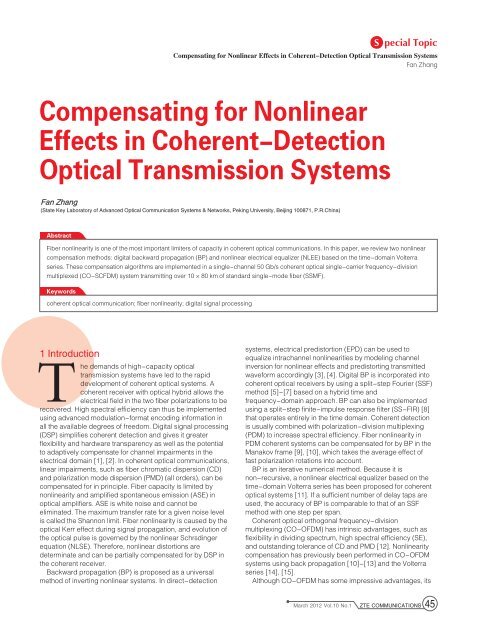ZTE Communications
ZTE Communications
ZTE Communications
You also want an ePaper? Increase the reach of your titles
YUMPU automatically turns print PDFs into web optimized ePapers that Google loves.
Compensating for Nonlinear<br />
Effects in Coherent-Detection<br />
Optical Transmission Systems<br />
Fan Fan Zhang Zhang<br />
(State Key Laboratory of Advanced Optical Communication Systems & Networks, Peking University, Beijing 100871, P.R.China)<br />
Abstract<br />
Fiber nonlinearity is one of the most important limiters of capacity in coherent optical communications. In this paper, we review two nonlinear<br />
compensation methods: digital backward propagation (BP) and nonlinear electrical equalizer (NLEE) based on the time-domain Volterra<br />
series. These compensation algorithms are implemented in a single-channel 50 Gb/s coherent optical single-carrier frequency-division<br />
multiplexed (CO-SCFDM) system transmitting over 10 × 80 km of standard single-mode fiber (SSMF).<br />
Keywords<br />
coherent optical communication; fiber nonlinearity; digital signal processing<br />
T1 Introduction<br />
he demands of high-capacity optical<br />
transmission systems have led to the rapid<br />
development of coherent optical systems. A<br />
coherent receiver with optical hybrid allows the<br />
electrical field in the two fiber polarizations to be<br />
recovered. High spectral efficiency can thus be implemented<br />
using advanced modulation-format encoding information in<br />
all the available degrees of freedom. Digital signal processing<br />
(DSP) simplifies coherent detection and gives it greater<br />
flexibility and hardware transparency as well as the potential<br />
to adaptively compensate for channel impairments in the<br />
electrical domain [1], [2]. In coherent optical communications,<br />
linear impairments, such as fiber chromatic dispersion (CD)<br />
and polarization mode dispersion (PMD) (all orders), can be<br />
compensated for in principle. Fiber capacity is limited by<br />
nonlinearity and amplified spontaneous emission (ASE) in<br />
optical amplifiers. ASE is white noise and cannot be<br />
eliminated. The maximum transfer rate for a given noise level<br />
is called the Shannon limit. Fiber nonlinearity is caused by the<br />
optical Kerr effect during signal propagation, and evolution of<br />
the optical pulse is governed by the nonlinear Schrödinger<br />
equation (NLSE). Therefore, nonlinear distortions are<br />
determinate and can be partially compensated for by DSP in<br />
the coherent receiver.<br />
Backward propagation (BP) is proposed as a universal<br />
method of inverting nonlinear systems. In direct-detection<br />
S pecial Topic<br />
Compensating for Nonlinear Effects in Coherent-Detection Optical Transmission Systems<br />
Fan Zhang<br />
systems, electrical predistortion (EPD) can be used to<br />
equalize intrachannel nonlinearities by modeling channel<br />
inversion for nonlinear effects and predistorting transmitted<br />
waveform accordingly [3], [4]. Digital BP is incorporated into<br />
coherent optical receivers by using a split-step Fourier (SSF)<br />
method [5]-[7] based on a hybrid time and<br />
frequency-domain approach. BP can also be implemented<br />
using a split-step finite-impulse response filter (SS-FIR) [8]<br />
that operates entirely in the time domain. Coherent detection<br />
is usually combined with polarization-division multiplexing<br />
(PDM) to increase spectral efficiency. Fiber nonlinearity in<br />
PDM coherent systems can be compensated for by BP in the<br />
Manakov frame [9], [10], which takes the average effect of<br />
fast polarization rotations into account.<br />
BP is an iterative numerical method. Because it is<br />
non-recursive, a nonlinear electrical equalizer based on the<br />
time-domain Volterra series has been proposed for coherent<br />
optical systems [11]. If a sufficient number of delay taps are<br />
used, the accuracy of BP is comparable to that of an SSF<br />
method with one step per span.<br />
Coherent optical orthogonal frequency-division<br />
multiplexing (CO-OFDM) has intrinsic advantages, such as<br />
flexibility in dividing spectrum, high spectral efficiency (SE),<br />
and outstanding tolerance of CD and PMD [12]. Nonlinearity<br />
compensation has previously been performed in CO-OFDM<br />
systems using back propagation [10]-[13] and the Volterra<br />
series [14], [15].<br />
Although CO-OFDM has some impressive advantages, its<br />
March 2012 Vol.10 No.1 <strong>ZTE</strong> COMMUNICATIONS 45

















